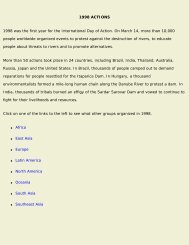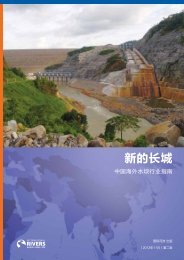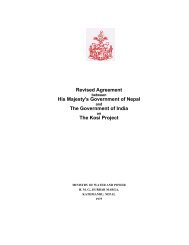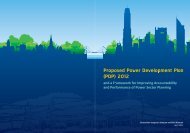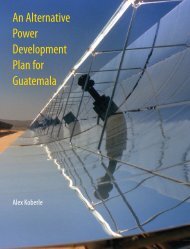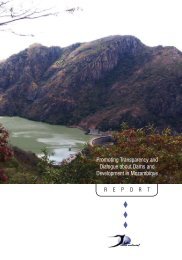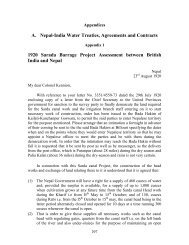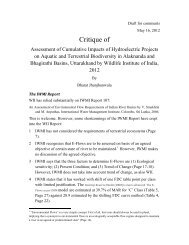Mountains of Concrete - International Rivers
Mountains of Concrete - International Rivers
Mountains of Concrete - International Rivers
You also want an ePaper? Increase the reach of your titles
YUMPU automatically turns print PDFs into web optimized ePapers that Google loves.
Social and EnvironmentalImpactsThe World Bank says that “the Himalayan hydropower sites are, from a social and environmental perspective,among the most benign in the world.” 77 This is a patently false assertion. Dams in the Himalayas will have socialand environmental impacts similar to dams in other parts <strong>of</strong> South Asia, which have proven very harmful. The lowpopulation density in these areas is sometimes put forward to argue that the projects are benign from a social impactpoint <strong>of</strong> view. Indeed, this very fact can mean that the populations are actually more vulnerable to displacement andthat the impacts <strong>of</strong> displacement would thus be more severe. In fact, due to the peculiar geographical and culturalcircumstances, dams in the Himalayas will have some serious impacts not seen elsewhere.Direct SubmergenceDirect submergence <strong>of</strong> a large number <strong>of</strong> houses, villages,cultivated lands and forests remains a serious issue. Forexample, the Tehri project in Uttarakhand, India has led tothe direct submergence <strong>of</strong> the town <strong>of</strong> Tehri, 37 villagesfully and 88 partially. More than 10,000 families have beendisplaced. 78 The Tipaimukh project in Manipur, India, isgoing to submerge an area <strong>of</strong> 292 km 2 . The EnvironmentalImpact Assessment (EIA) <strong>of</strong> the project boasts that it will havea “meagre impact,” as it will submerge a population <strong>of</strong> only2,027 in 313 households in 12 villages. 79 Although it doesnote that lands and farms <strong>of</strong> 91 villages will be submergedProtest in Bangladesh against the environmental clearance <strong>of</strong>Tipaimukh Dam in India, 2008. The dam will submerge 292 sqkm, affecting 91 villages in India, and people in Bangladesh areconcerned that the project will drastically and adversely alter riverflow in the downstream region in Bangladesh, with severe socialand environmental consequences. Photo: Angikar BangladeshFoundationby the reservoir, they are inexplicably not considered to be“impacted” by this project.In Pakistan, the reservoir <strong>of</strong> the Diamer-Bhasha Dam willspread over 130 km 2 (32,000 acres) and 24,500 people will beaffected. 80 [See Box 5, page 25] Given the size <strong>of</strong> the reservoir,the resettlement figures seem to be an underestimate.The 600 MW Akhori project is expected to havea submergence area <strong>of</strong> 240 km 2 (59,200 acres), and willdisplace 49,300 people.The website <strong>of</strong> the West Seti project in Nepal says that“2,322 ha [23 km 2 ] <strong>of</strong> land will be acquired for permanentproject features and 678 ha [7 km 2 ] for the transmissionlines.” 81 It also says that 1,383 households will need to beresettled from the project site, and another 186 householdsfor the transmission lines. However, it does not mention thetotal land submerged or the total number <strong>of</strong> people affected,as in many cases people severely affected are not necessarilyslated for resettlement. Other estimates put the number <strong>of</strong>people affected by this project at 15,000. 82Indeed, the impact <strong>of</strong> Himalayan dams is likely to bemuch greater if the totality <strong>of</strong> the impacts <strong>of</strong> the destruction<strong>of</strong> the resource base, including rivers, fisheries and forests, istaken into consideration.Loss <strong>of</strong> the Resource BaseMost <strong>of</strong> the people living on the banks <strong>of</strong> rivers in theHimalayan region derive their sustenance from their naturalresource base. Agriculture provides food and other needs.The river gives fish, and also provides water for daily use andirrigation. It can also provide transportation routes. Forestsprovide a variety <strong>of</strong> things including fruits, vegetables, timber,fodder and in many areas they are also an integral part <strong>of</strong> thejhum, or shifting cultivation, cycle. 83 This richness and multidimensionality<strong>of</strong> the resource base is <strong>of</strong>ten not understoodnor taken into account by planners when considering theimpacts <strong>of</strong> projects.M o u n ta i n s o f C o n c r e t e : D a m B u i l d i n g i n t h e H i m a l aya s | 2 1




